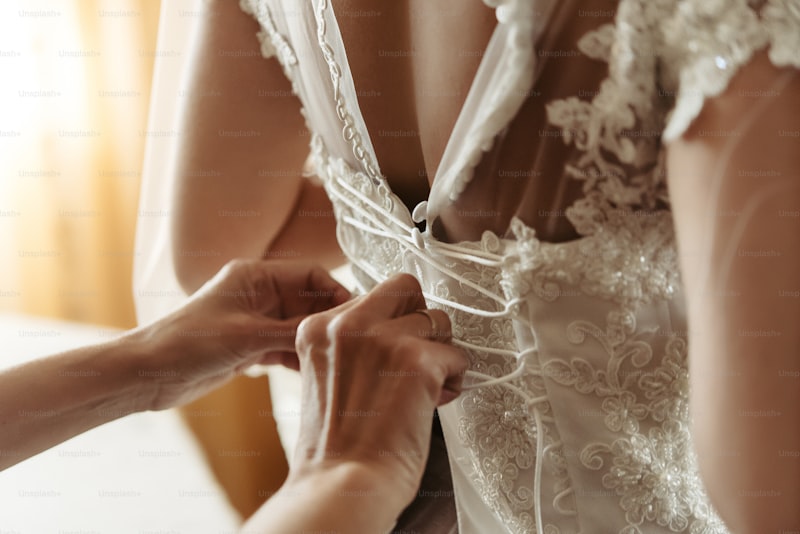Lengthening or Shortening Your Bridal Gown: A Comprehensive Guide
Understanding the Basics of Bridal Gown Alterations
Choosing your wedding dress is one of the most exciting moments during wedding planning. However, once you've chosen your dream gown, you may realize that some alterations are necessary to ensure a perfect fit. Whether you're considering lengthening or shortening your bridal gown, it's important to understand what these alterations entail and how they can affect your overall wedding day look.
Why Lengthening or Shortening Matters
It's crucial to aim for a gown that flatters your body shape and enhances your features. Sometimes, a dress may fit beautifully at the bodice but require adjustments in length to achieve the look you desire. Each wedding gown is uniquely designed, and alterations can make a significant difference in how the dress ultimately appears.
Lengthening Your Bridal Gown
Lengthening a bridal gown is a common alteration, especially for brides who may have a specific height in mind for their dress or plan to wear high heels. Here are some reasons you might consider lengthening your gown:
- If the original hem sits too high and does not offer the desired elegance.
- If you wish to wear taller shoes on your wedding day.
- If you want to add a personal touch, like a lace border or extra embroidery.
Lengthening a gown typically involves adding fabric at the hem. This can be done through various methods including:
- Using Extra Fabric: If you have access to leftover fabric from the original gown, a skilled tailor can seamlessly integrate it into the hem.
- Adding a Lace or Tulle Border: For a whimsical or vintage effect, incorporating additional decorative elements can lengthen the gown while enhancing its overall aesthetic.
Shortening Your Bridal Gown
Conversely, shortening a bridal gown is also a common alteration. Here are some reasons brides choose to shorten their dresses:
- If the original length is too long and poses a risk of tripping.
- If you prefer a more casual, contemporary look.
- If you wish to show off unique shoes or accessories.
Shortening involves cutting the hem to the desired length, and it’s important to consider the dress design:
- Preserving the Design: Some dresses have intricate designs at the hem that may get lost if shortened too much.
- Adjusting the Train: If your dress has a train, shortening it may also alter its shape. Discuss with your tailor the potential impacts before making a decision.
| Comparison of Lengthening vs. Shortening | |
| Lengthening | Shortening |
| Increases the elegance of the dress. | Provides a modern and practical look. |
| Can add extra fabric for customization. | May require removing fabric without losing design elements. |
| Ideal for taller brides or those desiring height. | Great for petite brides or those wanting to show off shoes. |
Consulting with a Professional Tailor
Regardless of whether you are lengthening or shortening your bridal gown, consulting with a professional tailor is essential. A skilled tailor will assess the fit and provide recommendations tailored to your unique gown and body shape. When consulting with a tailor, be sure to take the following steps:
- Bring Your Wedding Shoes: Wear the shoes you plan to wear on your big day to accurately determine the ideal length.
- Consider Your Wedding Venue: The setting—be it a beach, formal hall, or garden—can influence your dress's length necessity.
- Communicate Your Vision: Make sure to express your expectations clearly. A picture of your desired length can be very helpful.
Budgeting for Alterations
Bridal gown alterations can vary widely in cost depending on the extent of the changes. On average, brides may spend anywhere from $150 to $600 for alterations. Factors that affect the price include:
- Complexity of the Alteration: Simple hem adjustments will cost less than intricate changes involving adding or removing layers, adjusting the bodice, etc.
- Location: Tailors in larger cities may charge more due to higher living costs.
- Tailor's Experience: More experienced tailors may charge premium rates for their services.
Common Questions Related to Gown Alterations
Here are some questions commonly asked by brides regarding lengthening or shortening their bridal gowns:
- How long before my wedding should I schedule alterations? It’s recommended to begin the alteration process at least 2-3 months before your wedding day.
- Can I alter a dress I purchased online? Yes! However, ensure you know the return policy for online purchases in case the alterations are not feasible.
- What if I change my mind about the length? Discuss this with your tailor; many alterations can be adjusted again if caught early in the process.
- Should I buy my dress a size bigger for alterations? It’s generally a good idea to account for alteration needs, but consult with a professional before purchasing.

Final Thoughts
Lengthening or shortening your bridal gown is an essential part of ensuring you look your best on your wedding day. With careful consideration, professional guidance, and a clear vision of what you want, you can achieve the perfect fit and stunning aesthetic for your special occasion. Remember that alterations are a personalized experience; what works for one bride may not apply to another. Always communicate openly with your tailor and embrace the changes that make your dress truly yours!